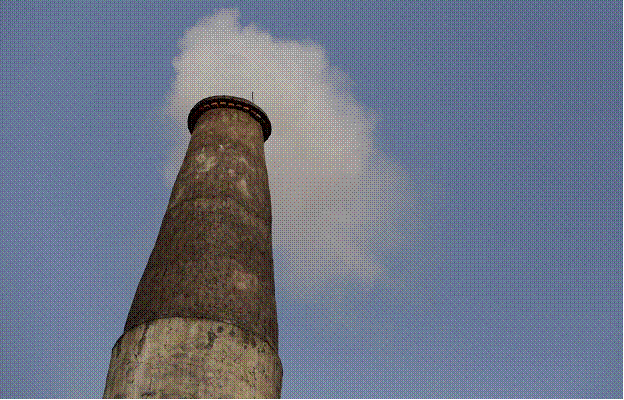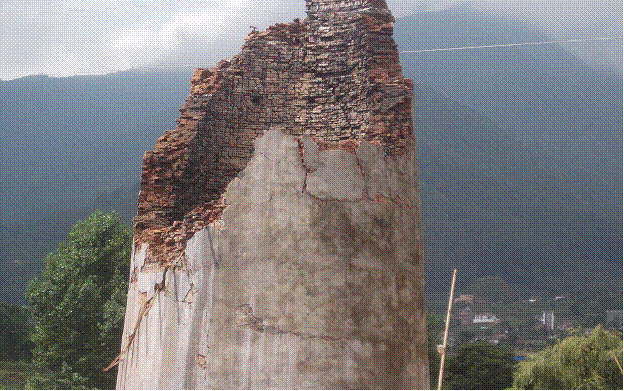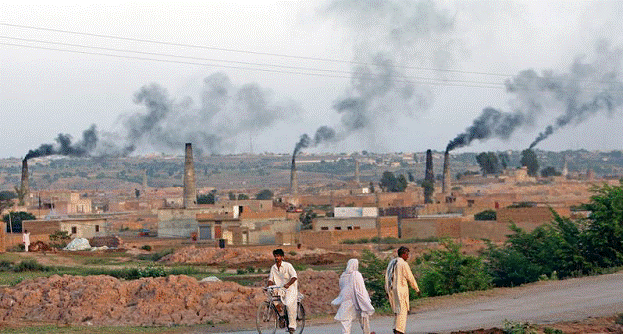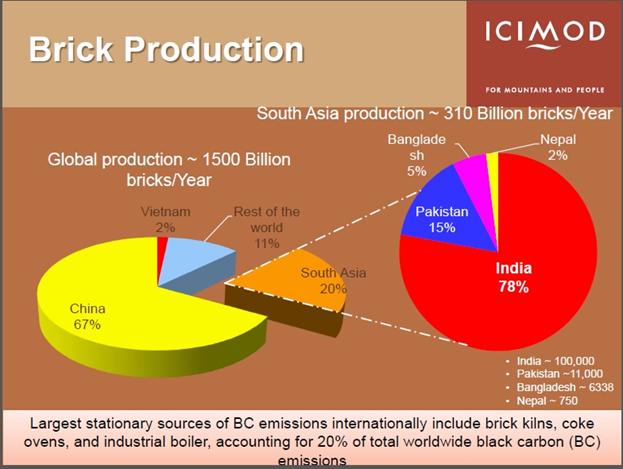The Smoke From The Brick Kilns In The HKH Region Are A Problem
Countercurrents.org
Tall and stately the brick kilns that dot the face of Kathmandu hide a deadly secret which has steadily, been a part, of the reason for the ABC (Asian Brown Cloud) which is causing a thick and unsightly fog over Kathmandu valley. The cloud is not just a health hazard but it affects the livelihood of hundreds of Nepali tourist operators, who express distress that the magnificent Himalayas, which the tourists come to see, are shrouded in this thick fog.

We were taken on a field trip by ICIMOD ( International Centre for Mountain Development) in Kathmandu to see a kiln which was being rebuilt after being dropped and destroyed in the April 2015 earthquake. New technology is being brought in and is being inculcated in the new kilns being built. The technology is clean and sustainable, said Anita Karki a Gender and Energy Development Specialist from ICIMOD and will replace the old Bull's Trench Kilns. The Bull's Trench system is extremely polluting, expending huge particulate matter into the air due to poor combustion. The new kiln being built by the owner of the kiln we went to see, is a design given by ICIMOD which will help clean up the combustion process.

" A large part of the observed change in the region's climate is by the presence of aerosols containing black carbon in the atmosphere. Black carbon is the product of incomplete burning which could be from brick kilns, the exhaust fumes, from diesel vehicles and burning of waste and forest fires," says senior atmospheric scientist Arnico Panday from ICIMOD in Kathmandu. If the mountains are being hidden by this dreadful fog since Kathmandu valley is a bowl like structure, then it is a cause for concern, for the tourism industry.
Field Visit
A bus load of journalists were taken on a field visit to a brick kiln in Kathmandu. We clambered all over the area looking at the entire process in making the brick which is used to erect most of Nepal's buildings. It was strange to see an ugly grey soil, formed into a brick shape, which would turn into a warm terracotta colour after being fired.
The point that shocked most of us environmental journalists was the degradation of the soil and the destruction of what once were fertile paddy fields. The soil is just scooped out and made into bricks. Poor farmers not realising the destruction that is being done to their land, get enticed by money to lease their fields.

During a talk given to us by Bidya Banmali Pradhan Associate Coordinator –Atmosphere Initiative Atmospheric Environment Specialist in ICIMOD she spoke about the negatives of brick making, which many of us learned of for the first time.
There was a loss of agricultural top soil, land degradation due to unorganised mining of the soil. We saw huge mechanised earth movers being used to scoop out the top soil.
Air pollution is obvious, with black carbon spewing into the air around. This has an immense health impact on workers and people who live around the brick kiln. There is a large impact on vegetation and agriculture as well, as fertile land is given over to the brick makers. Where there are several kilns in the same area, there is a high impact on air pollution in the area. According to Ms Pradhan, there is also a high impact on air quality of cities and she cited a recent study for several Indian cities which reveals that brick kilns are responsible for 15 -25% of PM2.5in ambient air. These kilns are also responsible for Global warming due to CO2and Black Carbon emissions

Credit: ICIMOD
Check out the quantum of bricks produced in South Asia in the figure above: 310 million bricks per year. Nepal accounts for just 2% and India 78% which is the highest in the region.
In a paper by A. K. Raut, who works for Clean Energy Nepal and published in the Himalayan Journal of Science (Himalayan Journal of Sciences 1(1): 59-61, 2003) he says, Kathmandu Valley' is vulnerable to air pollution problem due to its topography, which restricts the wind movement and allows pollutants to remain within the valley. Brick kilns, operating in the Valley, are known to be a prime cause of air pollution. There are currently more than 125 brick kilns operating in Kathmandu valley deteriorating its air quality and degrading the health of the people living near the kilns.
Recent studies have found that the concentration of particulate matter in the air in an area with brick kilns is three times higher when the kilns are operating than during the off-season. Similarly, the health of students studying at a school situated near a brick kiln was found to be significantly worse than that of students studying in a similar school but located in an area without brick kilns.
Other environmental costs of the brick kilns are the reduction in the soil fertility, reduced visibility, drying ground water sources. The use of an old and inefficient technology called Bull's Trench kilns and low quality fuel are the main causes of the problem. Recently the government has decided to ban Bulls Trench brick kilns in Kathmandu. As a result, entrepreneurs are searching for environment friendly and cost effective alternative technologies. There are some technologies currently in practice in India like Vertical Shaft Brick Kiln, Fixed Chimney Kilns which are environment friendly and economically sound. Introduction to these technologies in Nepal can save both ecology and economy.
This is where ICIMOD has stepped in with their technology and because of the loss of kilns due to the earthquake, there is hope that the new kilns will be revolutionised.
Marianne de Nazareth

